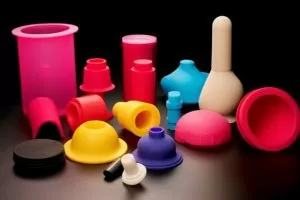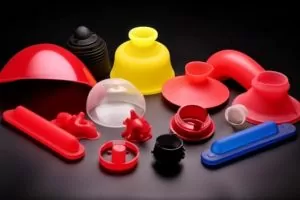Introduction
Silicone rubber is an extraordinary material renowned for its versatile properties that make it highly valued across industries. Composed of silicon, oxygen, carbon, and hydrogen atoms, silicone rubber stands out among other materials with its exceptional properties that set it apart.
Silicone rubber parts offers exceptional temperature resistance, making it suitable for applications in extreme environments. Even at higher temperatures, its physical and mechanical properties remain intact, providing durability and reliability in demanding circumstances.

Silicone rubber’s chemical stability protects it against degradation from chemicals, solvents and oils; combined with its ability to resist UV rays and weathering effects, making silicone rubber an excellent material choice for outdoor applications and ensuring long-term performance.
Silicone rubbers stands out with its flexibility and elasticity, boasting exceptional tear strength as well as molding into intricate shapes for use in dynamic sealing applications and complex designs.
Silicone rubber’s versatility extends across various industries. Automotive industries use silicone rubber gaskets and seals due to its high consistency and resistance to extreme temperatures; healthcare fields utilize it in medical devices and implants because of its biocompatibility and ability to withstand sterilization processes.

silicone rubber has many applications across electrical, electronics, aerospace, household products and industrial sectors. Due to its electrical insulation properties and high-temperature resistance it makes an excellent material choice for electrical connectors, insulators and motor applications.
Silicone rubber’s unique properties, including temperature resistance, chemical stability, flexibility and durability make it a popular material in numerous industries. Its many applications highlight its significance while contributing to advances in technology, healthcare and everyday products.
II. Different Types of Silicone Rubbers
A. Solid Silicone Rubbers
Solid Silicone Rubber Also referred to as high-consistency rubber (HCR), solid silicone rubber is a type of silicone rubber with solid properties that is composed of relatively long polymer chains
Solid with high molecular weight. Due to these superior mechanical and physical properties, solid silicone rubbers is widely utilized across multiple industries.
- Definition and characteristics of solid silicone rubber:Solid silicone rubbers is a rubber-like material with a molecular structure consisting of silicon, oxygen, carbon, and hydrogen atoms. It is characterized by its solid form at room temperature and its ability to maintain its elasticity and shape even at high temperatures. Some key characteristics of solid silicone rubbers include:
- High temperature resistance: Solid silicone rubbers can withstand a wide temperature range, from extremely high temperatures to freezing conditions, without losing its physical properties.
- Chemical resistance: It exhibits good resistance to chemicals, oils, and solvents, making it suitable for applications where exposure to these substances is common.
- Mechanical strength: Solid silicone rubbers possesses excellent mechanical properties, including high tensile strength, tear resistance, and elongation, allowing it to withstand mechanical stress and deformation.
- Electrical insulation: It exhibits good electrical insulation properties, making it suitable for applications in the electrical and electronics industry.
- Mechanical and physical properties:Solid silicone rubber offers a range of mechanical and physical properties that contribute to its versatility and reliability. Some key properties include:

- High tensile strength: Solid silicone rubbers exhibits good tensile strength, allowing it to withstand pulling or stretching forces without breaking.
- Tear resistance: It has excellent tear strength, making it resistant to tearing or ripping under pressure.
- Elongation at break: Solid silicone rubber can stretch without breaking, exhibiting high elongation at break percentages.
- Compression set: It demonstrates good compression set resistance, meaning it can recover its original shape after being compressed for a period of time.
- Heat resistance: Solid silicone rubbers has excellent heat resistance, maintaining its integrity and properties even at high temperatures.
- Applications in automotive, medical devices, seals, and gaskets:Solid silicone rubber finds a wide range of applications across various industries. Some common applications include:

- Automotive industry: Solid silicone organic rubber is used in automotive parts such as gaskets, seals, O-rings, and hoses due to its high temperature resistance and compatibility with automotive fluids.
- Medical devices: It is utilized in medical devices, implants, and components due to its biocompatibility, durability, and ability to withstand sterilization processes.
- Seals and gaskets: Solid silicone rubber is commonly used for sealing applications in industries such as aerospace, industrial manufacturing, and HVAC systems, where resistance to extreme temperatures, chemicals, and pressure is required.
B. Liquid Silicone Rubber (LSR)
Liquid silicone rubber (LSR) is a two-part, platinum-catalyzed silicone material that is in liquid form at room temperature. It offers unique advantages in manufacturing processes due to its flowability and easy moldability.
- Definition and characteristics of LSR:Liquid silicone rubber (LSR) is a silicone material that consists of a liquid base and a catalyst. It undergoes a crosslinking reaction when mixed together and cured, resulting in a solid rubber-like material. Some key characteristics of LSR include:

- Low viscosity: LSR has a low viscosity in its uncured state, allowing it to flow easily and fill intricate molds, resulting in high-precision parts.
- Fast curing: LSR cures relatively quickly, reducing processing times and increasing manufacturing efficiency.
- High-temperature stability: Once cured, LSR exhibits excellent stability at high temperatures, maintaining its shape and properties under heat.
- Biocompatibility: LSR is biocompatible and hypoallergenic, making it suitable for medical and healthcare.
III. Other Types of Silicone Materials
A. Overview of different silicone materials beyond silicone rubber:
While silicone rubber is widely recognized for its applications and properties, there are other types of silicone materials that offer unique characteristics and find applications in various industries. These materials include silicone elastomers, fluids, resins, gels, foams, adhesives, and sealants.

B. Briefly discuss silicone elastomers, fluids, resins, gels, foams, adhesives, and sealants:
- Silicone Elastomers:
- Silicone elastomers are materials that exhibit rubber-like properties and flexibility, similar to makes silicone rubber.
- They are used in applications where high elasticity, tear resistance, and durability are required.
- Silicone elastomers find applications in automotive parts, electronics, industrial gaskets, and seals.
- Silicone Fluids:
- Silicone fluids are silicone-based liquids that have a range of viscosities, from low to high.
- They offer excellent heat stability, low surface tension, and electrical insulation properties.
- Silicone fluids find applications as lubricants, hydraulic fluids, heat transfer fluids, and dielectric fluids in various industries.
- Silicone Resins:
- Silicone resins are highly crosslinked silicone polymers that exhibit excellent heat resistance and electrical insulation properties.
- They are commonly used in coatings, encapsulants, adhesives, and electrical insulation applications.
- Silicone resins find applications in industries such as electronics, automotive, and construction.
- Silicone Gels:
- Silicone gels are soft, translucent materials that offer high elongation and low compression set.
- They have a gel-like consistency and are commonly used in applications where cushioning, vibration damping, and softness are required.
- Silicone gels find applications in electronics, medical devices, and cosmetic products.
- Silicone Foams:
- Silicone foams are lightweight materials with open or closed-cell structures, offering excellent cushioning and insulation properties.
- They find applications in industries such as automotive, aerospace, and construction for gaskets, insulation, and sealing purposes.
- Silicone Adhesives and Sealants:
- Silicone adhesives and sealants are formulated to provide strong adhesion and sealing properties.
- They have excellent resistance to temperature, chemicals, and weathering.
- Silicone adhesives and sealants find applications in construction, automotive, electronics, and aerospace industries.

C. Highlight their key properties and applications:
suitable for various applications. Here are some key properties and applications of each:
- Silicone elastomers: High elasticity, tear resistance, and durability; used in automotive parts, electronics, and industrial seals.
- Silicone fluids: Excellent heat stability, low surface tension, and electrical insulation; used as lubricants, hydraulic fluids, heat transfer fluids, and dielectric fluids.
- Silicone resins: Superior heat resistance, electrical insulation, and adhesion properties; used in coatings, encapsulants, adhesives, and electrical insulation applications.
- Silicone gels: Soft, translucent, and flexible; provide cushioning, vibration damping, and are used in electronics, medical devices, and cosmetics.
- Silicone foams: Lightweight, cushioning, and insulation properties; used in automotive, aerospace, and construction for gaskets, insulation, and sealing.
- Silicone adhesives and sealants: Strong adhesion, resistance to temperature, chemicals, and weathering; used in construction, automotive, electronics, and aerospace industries for bonding and sealing applications.

These different silicone materials offer a wide range of properties and applications, providing engineers and designers with options to choose the most suitable material for their specific needs.
IV. Applications of Silicone Rubbers
A. Automotive Industry:
Silicone rubber plays a vital role in the automotive industry, where it is utilized for various applications due to its unique properties. Some common applications include:
- Gaskets, seals, and O-rings: Silicone rubber is used for its high-temperature resistance and compatibility with automotive fluids, ensuring reliable sealing in engines, transmissions, and other automotive systems.
- Hoses and connectors: Silicone rubber’s flexibility, durability, and resistance to extreme temperatures make it suitable for automotive hoses and connectors, providing reliable fluid transfer in engines and cooling systems.
- Electrical insulation: Silicone rubber’s excellent electrical insulation properties make it ideal for automotive wiring harnesses, connectors, and insulators, ensuring reliable electrical performance.
B. Healthcare and Medical Devices:
Silicone rubber is extensively used in the healthcare and medical industry, thanks to its biocompatibility and durability. Some applications include:
- Medical implants: Silicone rubber is used for implants such as breast implants, cochlear implants, and facial implants due to its biocompatibility and ability to withstand long-term exposure to bodily fluids.
- Medical devices and equipment: Silicone rubber is used in a wide range of medical devices, including catheters, seals, tubing, and respiratory masks, due to its flexibility, sterilizability, and biocompatibility.
- Healthcare products: Silicone rubber is used in products such as prosthetics, wound dressings, and medical-grade adhesives for their comfortable fit, flexibility, and biocompatibility.
C. Electrical and Electronics:
Silicone rubber finds numerous applications in the electrical and electronics industry, where its unique properties are highly valued. Some common applications include:
- Insulation and cable coatings: Silicone rubber’s excellent electrical insulation properties and resistance to high temperatures make it ideal for insulating wires, cables, and electrical connectors.
- Keypads and buttons: Silicone rubber’s flexibility and durability are well-suited for keypads and buttons in electronic devices, ensuring reliable and long-lasting operation.
- Encapsulation and potting: Silicone rubber is used for encapsulating and potting electronic components to provide protection against moisture, chemicals, and mechanical stress.
D. Aerospace and Industrial Applications:
The aerospace and industrial sectors rely on silicone rubber for its exceptional properties in demanding environments. Some applications include:
- Sealing and gaskets: Silicone rubber is used for sealing applications in aerospace and industrial settings due to its resistance to extreme temperatures, pressure, and chemicals.
- Vibration dampening: Silicone rubber’s excellent flexibility and shock absorption make it suitable for vibration dampening applications in aerospace and industrial machinery, reducing noise and mechanical stress.
- O-rings and grommets: Silicone rubber’s resistance to extreme temperatures and chemicals makes it valuable for O-rings and grommets in aerospace and industrial equipment, ensuring reliable sealing and protection.

E. Household and Kitchenware:
Silicone rubber is widely used in household and kitchenware products due to its food-grade properties, flexibility, and durability. Some applications include:
- Bakeware and cooking utensils: Silicone rubber is used for baking mats, spatulas, and oven mitts due to its heat resistance, non-stick properties, and ease of cleaning.
- Kitchenware and storage: Silicone rubber is used in food storage containers, lids, and sealing rings for its flexibility, airtight sealing, and resistance to temperature variations.
- Baby products: Silicone rubber is employed in baby bottle nipples, pacifiers, and teething toys due to its softness, durability, and non-toxic nature.

F. Other industries and specialized applications:
Silicone rubber finds applications in various other industries and specialized applications, including:
- Industrial manufacturing: Silicone rubber is used in mold-making, prototyping, and 3D printing applications due to its ability to reproduce intricate details and withstand

Conclusion
Overall, silicone rubber products is an incredibly useful material that has applications across many industries. Due to its exceptional properties such as temperature resistance, chemical stability, flexibility and durability, silicone rubber makes an invaluable material in numerous sectors.
Silicone rubber’s significance in the automotive industry can be seen through its various applications: gaskets, seals, hoses and electrical insulation being just some. Meanwhile in healthcare and medicine it has applications as implants and healthcare products due to being biocompatible and sterilizable; electrical/electronic industries also benefit from its insulation properties, while aerospace/industrial sectors use silicone rubber’s excellent sealing, vibration dampening, O-ring applications etc.
Silicone products has long been prized in households and kitchenware due to its heat resistance and non-toxicity properties, making it suitable for bakeware, cooking utensils and baby products. Furthermore, silicone rubber finds use across industries including industrial manufacturing, mold making and prototyping.
Understanding the various silicone rubber materials – solid silicone rubber, liquid silicone rubber (LSR), and room temperature vulcanized (RTV) silicone – gives engineers and designers a wide array of choices when selecting suitable materials for specific applications. Each offers distinct properties and advantages such as heat resistance, flexibility, ease of molding and moldability.
Silicone rubber’s versatile properties and benefits have long made it a pivotal material in technology, healthcare, and everyday products. Thanks to its combination of properties – extreme temperature tolerance, chemical resistance, reliable sealing systems, comfort features, and safety requirements for various applications – silicone rubber makes an invaluable contribution.
Engineers and designers can take advantage of silicone rubber’s versatility by studying its many applications across industries and understanding its various forms and properties, enabling them to make informed choices when creating innovative solutions for diverse fields ranging from automotive and healthcare applications, electrical, household applications, as well as home renovation. Silicone rubber continues to contribute positively across multiple sectors.



